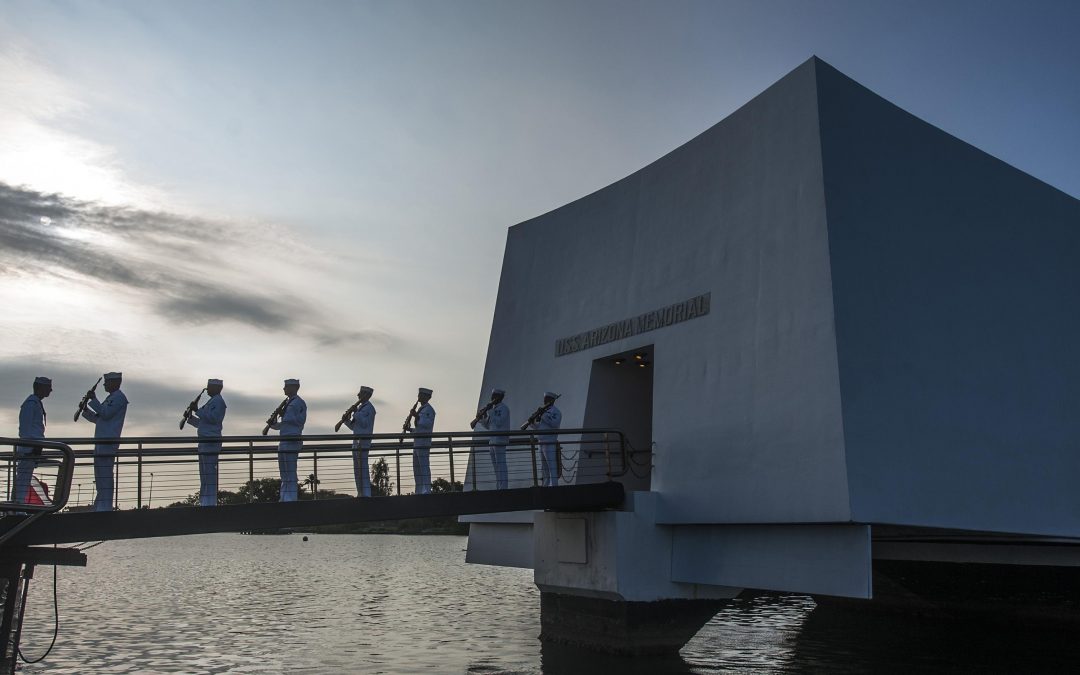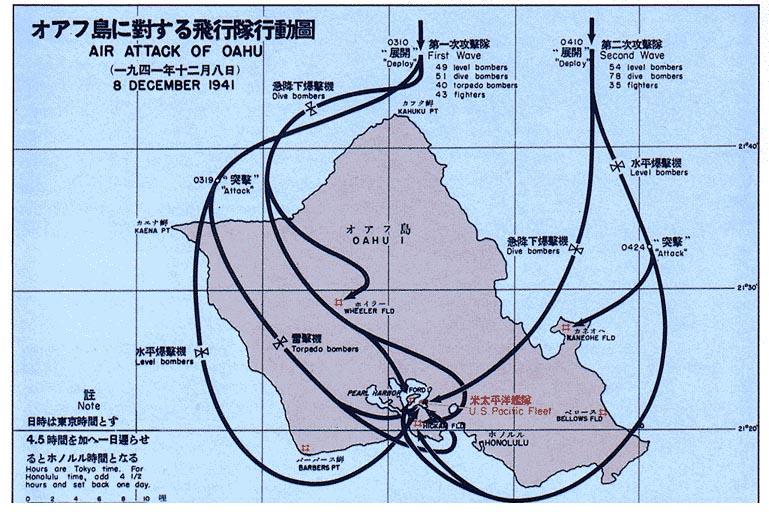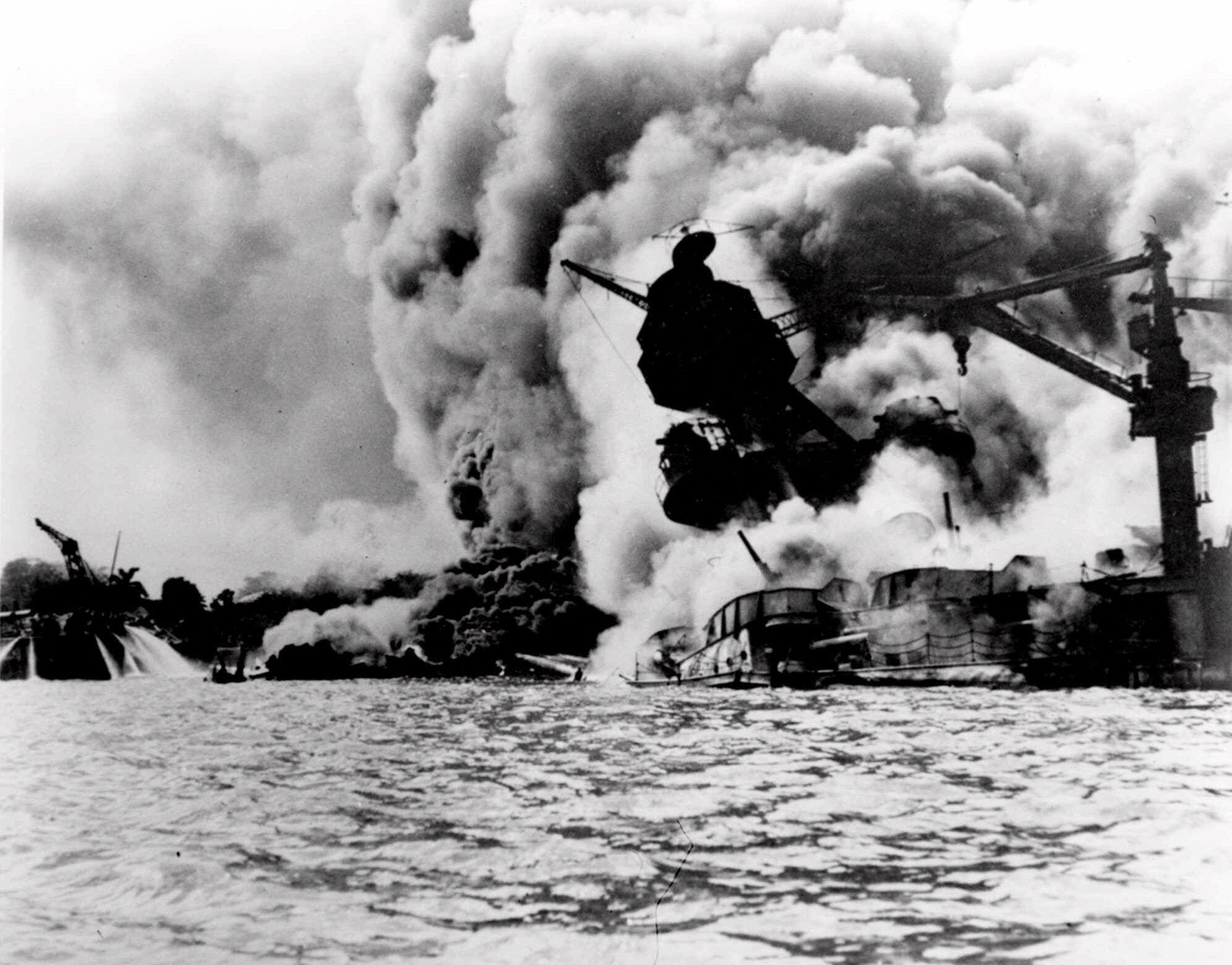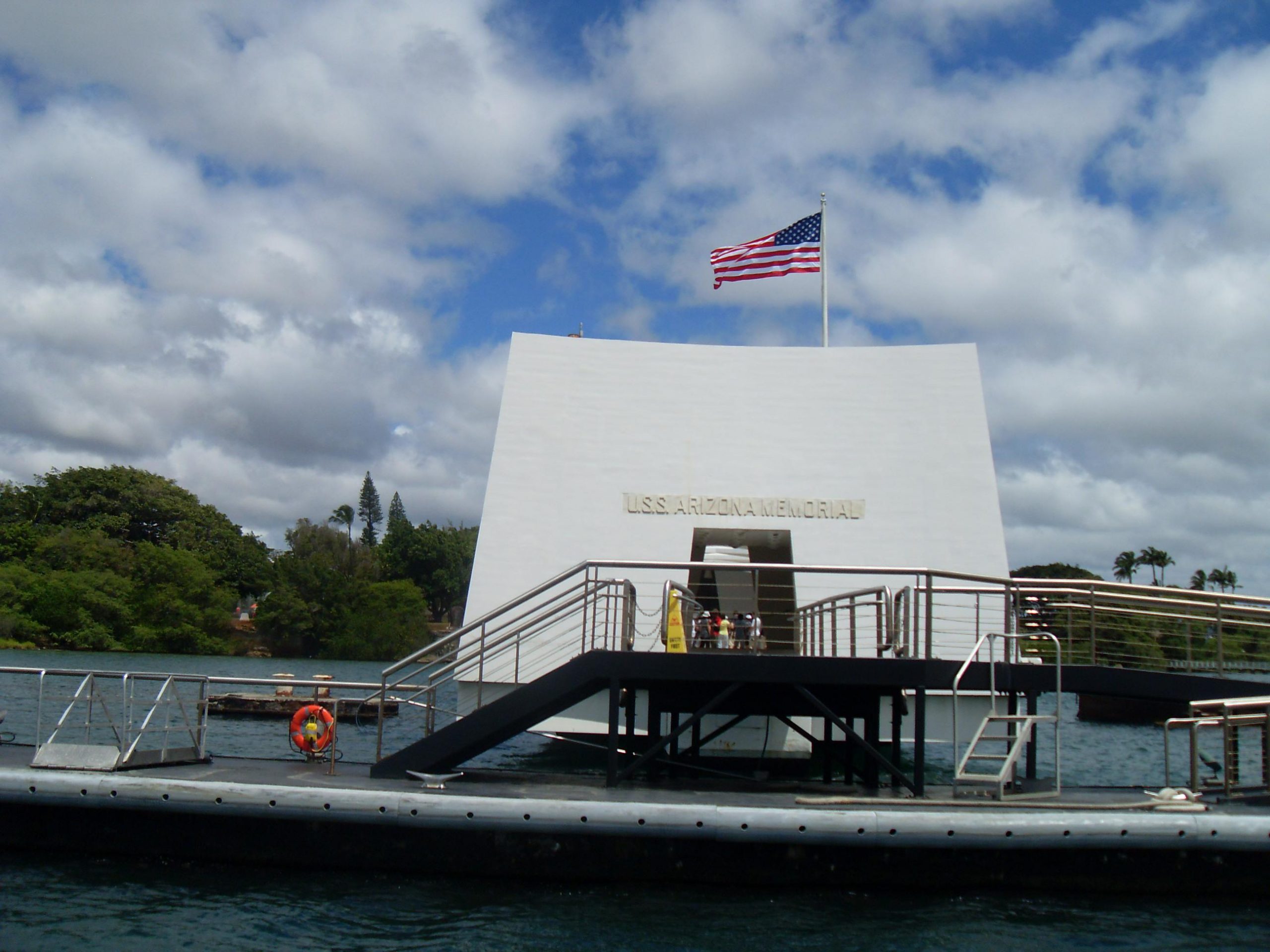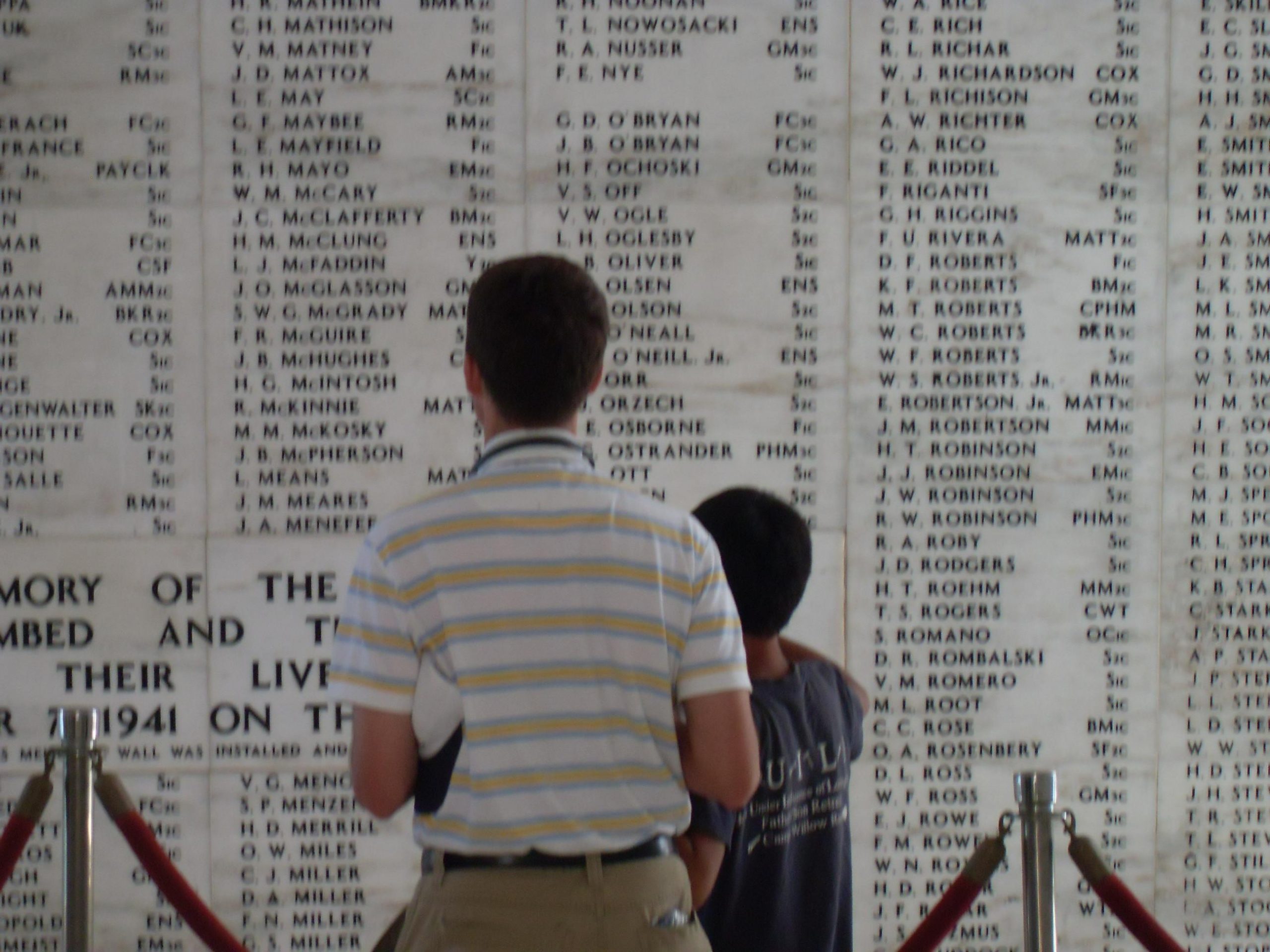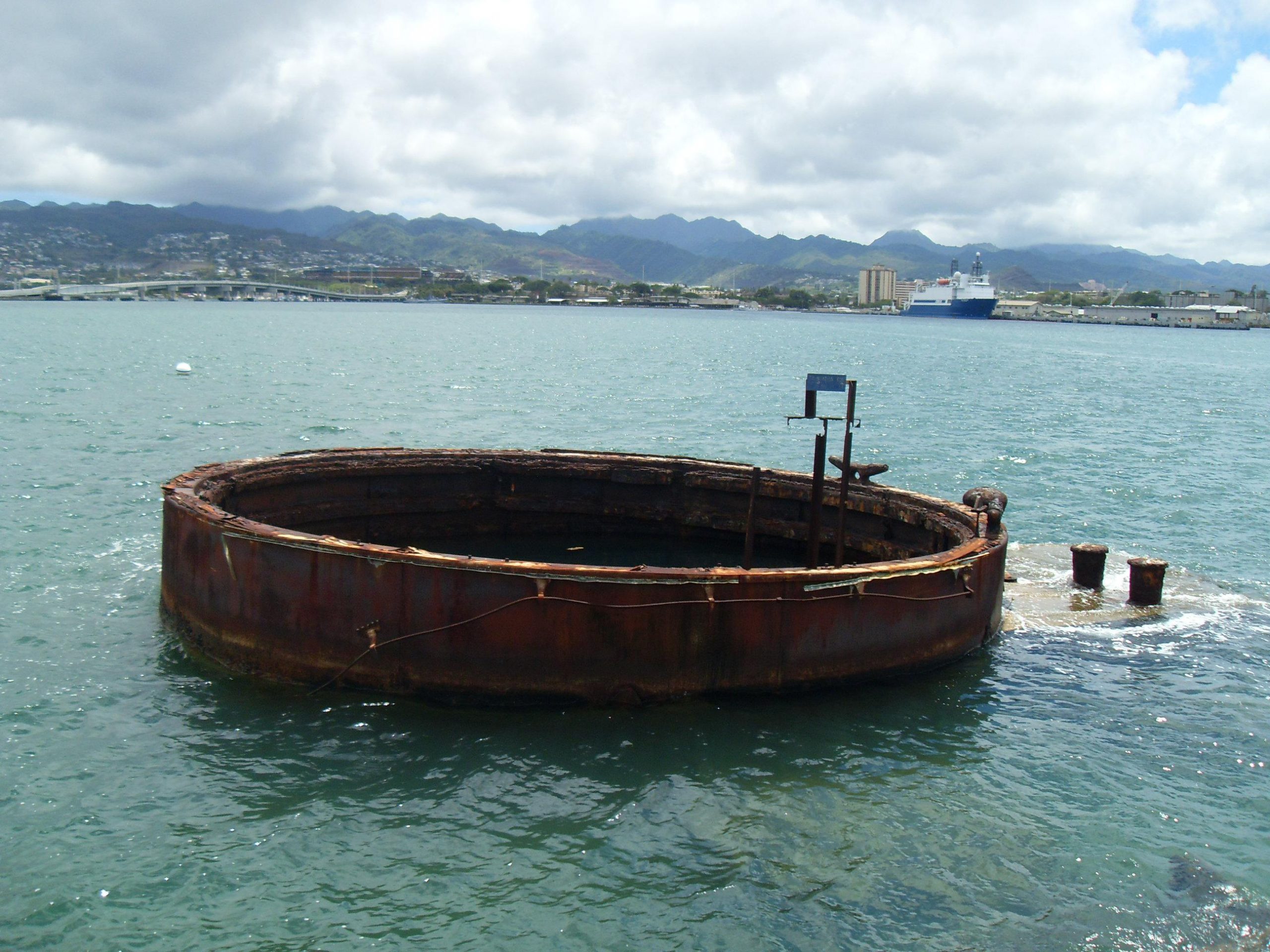| Pearl Harbor
Even among non-history types, these two words are highly recognized, and bring up images of attack, surprise, treachery, and war. Along with 9/11, the very name “Pearl Harbor” stirs up memories of death and pain. What was Pearl Harbor, and why is it so famous? Pearl Harbor is a famous navy base on the island of Oahu, Hawaii. Long recognized for its deep harbor and strategic location halfway between North America and Asia, it has long been a valued US naval base and supply station. It is a little-known fact that, during WW I, when the US and Japan were allies against Germany, the US actually trained Japanese pilots at Pearl Harbor. Therefore, those pilots knew the geography of the area, plus the lifestyle schedules of the men based there, very well. During the 1930’s, a time of global economic crisis, Japan, Germany, and Italy turned into right-wing, militaristic dictatorships. Also, during the 1930’s, Japan had been gradually attacking North China, which turned into full-scale war in 1937. (Some historians consider this the actual start of WW II.) The US, as an ally of China at that time, wanted to hinder and punish Japan for its aggression. However, since the US was still suffering from the Great Depression, and memories of World War I were still fresh in most Americans’ minds (it had only ended 23 years earlier), almost no Americans wanted to start a war with far-off Japan. (This reluctance to get involved in foreign matters is called “isolationism,” and it was very strong in the US before the Pearl Harbor attack.) So, the US policy was economic sanctions (punishment) of Japan, not military attack. The most punishing of the sanctions was the US embargo (refusal to sell) of oil and iron. (Imagine: the US at the time actually exported more oil than it imported; very different situation today.) As a resource-poor nation, Japan saw this oil embargo as a direct threat. But rather than negotiate with the US and withdraw from China, Japan’s leadership made the fateful decision to make a preemptive strike against the US. The Japanese goal was to control the East Asian/Pacific region, but they saw one potential challenger that could keep them from achieving their dream: the USA, with its large naval and air assets based at Pearl. In late November, the Japanese fleet left Japan and headed toward Hawaii, from which Japanese pilots would take off from the decks of Japanese aircraft carriers and bomb Pearl. While the Japanese fleet was sailing, Japan was conducting “peace talks” with the US. Their goal was to later declare war, then moments later launch the attack. However, because the declaration of war was lengthy and it took the Japanese delegates in Washington DC a long time to decode it, the attack actually occurred first, then Japan declared war. That fact enraged the US populace, who were infuriated at the “sneak attack.” The attack began at 7:48 am Sunday, Hawaiian time, when many US servicemen were still in bed or in the chow line for breakfast.
Route of Japanese attack on Pearl Harbor
Attack on Island of Oahu News of the attack was made public by radio at 2:30 pm, Eastern (New York/Washington DC) time. Many Americans were at home, resting after a morning church service and large Sunday lunch. If you can talk with Americans old enough to remember that moment, (those people are now in their upper 80’s or 90’s), they will often remember exactly where they were, and whom they were with, at that shocking moment. You can listen to some radio news broadcasts from that day here. Reports indicate that the Japanese military believed, after dealing a crushing blow to the US bases in Hawaii, the US government and public would be so shocked and dazed, they would seek peace. However, quite the opposite happened. Shocked by the attack but infuriated by the surprise nature of it, the American public overwhelmingly clamored for war against Japan. Not long before, public opinion surveys reported almost 90% of the Americans wanted to remain neutral in WW II, but the attack that Sunday morning changed everything. What effect did the attack on Pearl Harbor have on WW II? The impact was enormous. That day, President Roosevelt cabled his friend and British Prime Minister Winston Churchill, “Today all of us are in the same boat…and it is a ship which will not and cannot be sunk.” Churchill explained his emotions that night this way: “Silly people, and there were many, not only in enemy countries, might discount the force of the United States. Some said they were soft, others that they would never be united. They would fool around at a distance. They would never come to grips. They would never stand bloodletting. Their democracy and system of recurrent elections would paralyze their war effort. They would be just a vague blur on the horizon to friend or foe. Now we should see the weakness of this numerous but remote, wealthy, and talkative people. But I had studied the American Civil War, fought out to the last desperate inch. American blood flowed in my veins. I thought of a remark which Edward Grey had made to me more than thirty years before” that the United States is like ˜a gigantic boiler. Once the fire is lighted under it there is no limit to the power it can generate. Being saturated and satiated with emotion and sensation, I went to bed and slept the sleep of the saved and thankful.” (source) Why was the US in shock, but Churchill was rejoicing and grateful? Because until that day, only Britain and the USSR were standing against the Axis powers and were barely hanging on. He had been begging Roosevelt for war aid, but because of American isolationism, help had been limited. So, once the US was in the war, Churchill knew America’s great human and economic resources would be brought to bear and lead to eventual victory. The next day, December 8, President Franklin D. Roosevelt appeared before a joint session of Congress session of Congress and asked Congress to declare war against Japan. (According to the US Constitution, a president cannot declare war; that power is reserved to the Congress only.) In one of the most famous speeches in American history, FDR called December 7, 1941, “a date which will live in infamy.” (Hear the speech here.) Pearl Harbor is forever etched in the American mind. As a “total war,” the entertainment industry aided in the war effort in many ways, including the publishing of patriotic songs like “Let’s Remember Pearl Harbor.” Even after WW II and until today, Pearl Harbor stands as a warning against carelessness and complacency. For example, shortly after 7:00 on the morning of the attack, two American soldiers were using a brand-new radar device on the northern tip of Oahu Island and observed a large “blip” that they thought to be about 50 incoming airplanes. They reported that to the control center, first being told that nobody was on duty (being early Sunday morning), but they persisted and called again, this time getting Lieutenant Kermit Tyler, who when he heard the news, responded with his now infamous, “Don’t worry about it.” (Lt. Tyler passed away in 2010 at age 96.) In one of the big “what if’s” of history, if the US forces had been alerted to the attack some 45 minutes in advance, how might the outcome have been different? As it was, the entire US presence was caught totally unaware that fateful morning, unaware there was an attack until the first bombs began to fall. In an interesting side note, a Navy band began playing the American national anthem, “The Star-Spangled Banner” at 8:00 sharp on the deck of the USS Nevada, as, ironically, the band members began watching “the bombs bursting in air.” If there were one “silver lining” for the Americans that day, it was the fact that the three US aircraft carriers based at Pearl Harbor were gone that day, out on the open seas for maneuvers. An aircraft carrier is basically a kind of “floating airport,” so when it has planes aboard, it can project military power almost anywhere in the world. Therefore, those aircraft carriers were the main targets for the Japanese. So, despite the overwhelming Japanese victory that day, the Japanese leaders were not satisfied that afternoon, knowing that their primary objectives were still untouched and at large. Of course, when the US then began its war push against Japan after the attack at Pearl, those three aircraft carriers played a vital role in prosecuting the war. Still long after WW II, the attack that day and complete American unpreparedness serve as a warning. This bluegrass song “Let’s not sleep again” advises Americans to stay awake and alert, lest we be attacked again. (Bluegrass is a popular music style in the Appalachian region of the US.) With the horrific attacks on 9-11 and more recently in San Bernadino, California, the need to remain vigilant to preserve liberty is still crucial. For a brief overview of the Pearl Harbor background and attack, watch this three-minute video.
Pearl Harbor What if there had been no attack on Pearl Harbor? This is another one of those great “what ifs?” in history. Of course, there is no way to tell, but many historians believe the attack on Pearl Harbor, by bringing the US into WW II, was a crucial step in defeating the Axis powers and preserving democracy and liberty in the world. Here is the logic. The US, with its widespread popularity of isolationism, persistent economic problems from the Great Depression, and relatively fresh memories of WW I, would probably have never entered the war, without that attack. By late 1941, Britain was barely clinging to its island as practically the only non-Nazi area of Europe, and the USSR was reeling from its own surprise attack from Germany that summer. The German army was at the gates of Moscow, and one German unit got to within five miles of Moscow. In Asia, the Japanese were still grabbing huge swaths of China, and would soon conquer the Philippines, Indonesia, and Southeast Asia. The outlook for the Allies was grim indeed. If the US had not entered the war, many historians imagine Germany taking over the USSR, Britain, and Africa, and Japan taking over Australia, India, and the Pacific. Imagine WW II with both the USSR and Britain defeated, and you can imagine the entire Axis onslaught against only North and South America. Frightening to imagine. Two famous quotes related to Pearl Harbor–that may not be true Admiral Isoroku Yamamoto was perhaps Japan’s most brilliant strategist and the mastermind behind the Pearl Harbor attack. Few know that as a young man Yamamoto studied English at Harvard University from 1919-1921. Allegedly while planning the Pearl Harbor attack, some Japanese warlords urged an additional full attack on the mainland US; however, the more cautious Yamamoto spoke against such a move. It is widely claimed he retorted: “You cannot attack America–there is a gun behind every blade of grass.” This quote has not been found in print. Still, whether the quotation is true or apocryphal, it relates to a truth. Since many US private citizens owned guns and knew how to use them, any foreign attacker would have to deal not only with the US military, but also an armed (and very angry) US civilian population. Second, many claim Yamamoto after Pearl Harbor said, “I fear all we have done is awaken a sleeping giant and filled him with terrible resolve.” Here again, no written evidence of his having said this exists. It was a gripping, closing line in the 1970 movie Tora Tora Tora, and it has been quoted widely since, but there is no hard evidence he wrote or said that either. What is it like to visit Pearl Harbor today? As a history major and teacher, I have long been fascinated by Pearl Harbor. However, since I am from Roanoke, Virginia, a trip from the East Coast to visit Hawaii is neither fast nor cheap. So, in 2010, while planning our trip to Taiwan to visit family and lead a Summer English Camp for DreyerCoaching.com, I was delighted to schedule a lay-over in Honolulu on the return flight, for just a small airline fee. So, our family of six excitedly flew from Taipei to Tokyo, then to Honolulu for a marvelous week of vacation. After a very full summer of teaching English in Taiwan, the week on Oahu was a great time to relax and connect with each other. Before the trip, I had decided we would visit Pearl Harbor on our first day, because that was my top priority. I wanted to see it for myself, as a way to satisfy my personal curiosity and to improve my teaching practice, but it was also important to share that experience with my family. Early on our first day in Hawaii, we drove our rented van to the National Park site, getting there early to get a ticket for the boat ride to see the USS Arizona Memorial. That ship had sunk on December 7, and the memorial was built right over it. On one end of the memorial is the list of names of the sailors and marines who died aboard. In fact, the ship is only a few feet below the water surface, so visitors can look down and see much of the hull, and a few parts of the ship are even standing above the waterline. Particularly eerie is how some oil from the Arizona is still leaking, just a few drops at at time. You can stand there and, every few minutes, see a few drops of oil rise to the surface, break, and spread across the surface in a rainbow sheen. It’s hard to imagine that some crew member pumped that oil into the belly of the Arizona in 1941, unaware of the disaster that awaited them. Our family still remembers that visit to Hawaii and Pearl Harbor. If you have a chance, try to go. If you are a person who often flies between North America and Asia, you might want to consider scheduling a lay-over in Hawaii some time. It is an economical way to pay for your trip, and it is a great way to break up that long journey!
Dreyer Family at USS Arizona Memorial
Oil sheen leaking from the ship–since 1941!
The list of the fallen
Part of the USS Arizona still above water How does this relate to English classes with DreyerCoaching.com? There are many places to learn English, including American English. But our program is unique, in that not only do we teach “English language,” but also about “Life in America,” and that includes some holidays, current events, and historical happenings. A few years ago, I was having an online class with a student in Hsinchu, Taiwan, and it happened to be December 7. I had planned to briefly mention Pearl Harbor, then move into my planned lesson with our textbook. But as we started the class discussing the attack, the student asked a question, then another, then another. As I remember, I used a little Chinese to explain some points, but most of the class was in English–and this was with an elementary-aged, Chinese native-speaker student! Where is Pearl Harbor? Why did Japan want to attack America? What was it like? Each question of his led to another answer, plus I shared some images and maps using share screen, etc. As a teacher, I see conducting a class more like using a sailboat, than a motorboat. That is, as much as possible, tap into student interest and let that guide the class. The fifty minutes sped by, class time was up, and we had never touched our textbook. As we wrapped up, I told him, “Today we had a history class.” So here we had a student who practiced his English and learned about US history, all at the same time. Here is that student’s mother, talking about the “double benefit” of learning English AND history with us. Video is in Chinese; her remarks about our Pearl Harbor class begin around the 4:00 timestamp.) In late 2017, an advanced writing student had read this Pearl Harbor blog and wrote his own essay about the crucial 1942 Battle of Midway, which took place just six months after the Pearl Harbor attack and was the turning point in the Pacific Theater. You can read his essay and also watch a class video where he read his first draft and we discussed it. Click here. That is a unique advantage of studying English with DreyerCoaching.com: you learn English AND history! Come join us! UPDATE 12-7-21 (Note palindromic date) Today is the 80th anniversary of the attack. The Epoch Times carried this commentary. Dr. Fred Eichelman of Salem, Virginia was social studies department chairman at the high school my siblings and I attended in Roanoke County, Virginia. He wrote this today of his childhood memories of that day and WWII: “I was in First Grade when it happened. That particular Sunday I was in our guest room where my Grandmother Nannie was taking a nap. I was on the floor playing, would you believe, with toy soldiers. I can still hear my mother’s voice calling from downstairs. ‘Mom. We’re at war.’ At the time my dad worked in a department store and mom was an RN in a local hospital. This was in Cleveland, Ohio. The army would not accept my dad though he had been a regimental bugler in World War One. So, he quit his job as a Credit Manager and went to work in what we called a Defense Plant. My mom went to work for the Red Cross. We had a Victory Garden and raised chickens in the basement because of rationing. Warning. Raising chickens causes the hazard of a couple becoming pets and you would never eat a pet. As a kid I took part in paper and scrap drives and sold war bonds. We all felt we were a part of a united effort to defeat the Nazi and Tojo Empires. Never can I remember our nation so united. You did not think Democrat, Republican, Liberal or Conservative. Those titles were meaningless. We were all Americans.” Since 2010, based in the friendly USA State of Virginia, DreyerCoaching.com has been providing customized, high-quality, real-time language instruction via the internet to a global audience in their home, school, or office. Think how comfortable, confident and successful you or your child will feel, receiving personalized guidance from college-educated teachers who are native speakers and have bachelor’s, master’s, and doctoral degrees plus decades of teaching experience. Whether you are looking for help with the ABCs or the SATs, or college admissions to conversational English to business writing, we serve all ages and levels to help our students make dreams come true. Discover the Dreyer Difference. Take the first step and visit DreyerCoaching.com, send Scott an email, or schedule a free consultation to get started. 自 2010 年以来,DreyerCoaching.com 总部位于友好的美国弗吉尼亚州,一直通过互联网向全球观众在家中、学校或办公室提供有制度的、高质量的实时语言教学。 想想您或您的孩子会感到多么自在、自信和成功,从受过大学教育的教师那里获得个别的指导,这些教师都是以英语为母语,拥有学士、硕士和博士学位,以及数十年的教学经验的教师。 无论是从 英语ABC的基础课程 或 SAT 的帮助,就读美国高中,大学入学申请,还是从会话英语到商务写作,我们都为所有年龄和水平的学生提供服务,帮助我们的学生实现梦想。 发觉 Dreyer 的不同之处。 迈出第一步,游览 DreyerCoaching.com网站,向 Scott 发送电子邮件,可开始安排一个免费咨询。 |

